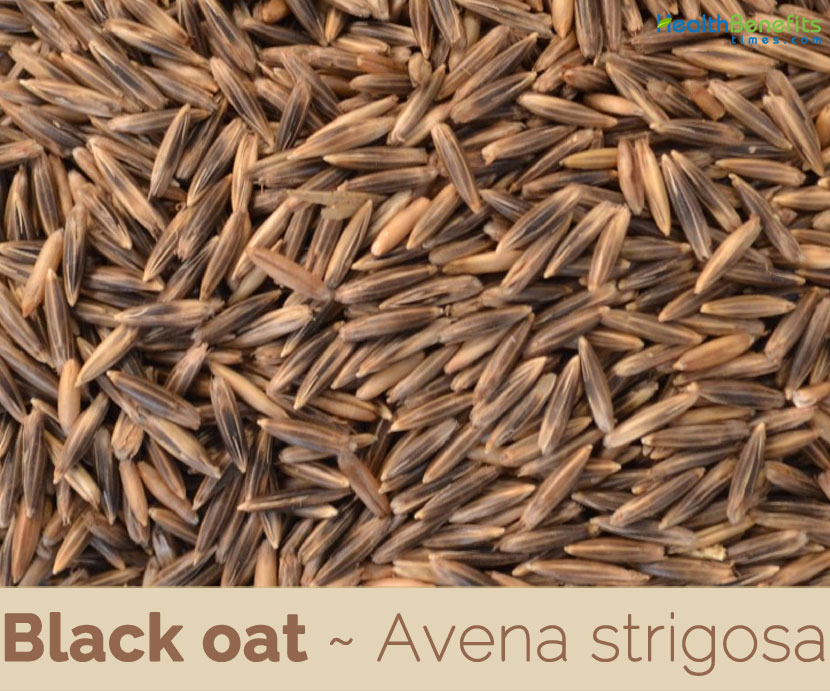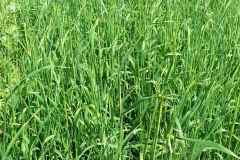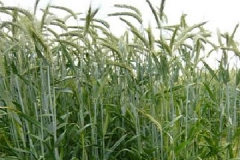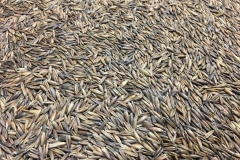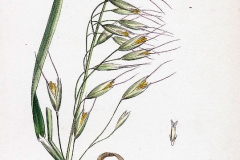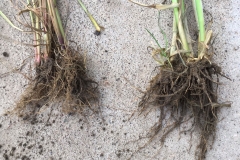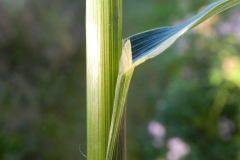Plant Description
Black oat is an upright, winter annual tufted grass that grows about 0.8-1.5 m, depending on growing conditions. The plant is found growing in dry wasteland, cultivated ground and meadows, especially on heavier soils. It does best on sandy or loamy soils but can also grow in heavy clay and soils with low nutrient value. It is not highly shade tolerant but can tolerate drought. The plant has dense root system. Black oat is a leafy species. The leaf blades are linear, flat, rough and numerous. Leaves are glabrous; blade finely scabrous, to 40 cm long and 12 mm wide. Ligule is membranous to 5 mm long.
The inflorescence is a loose open panicle. The panicle is drooping and bears pendulous, pedicellated spikelets. The inferior lemma is awned, straight and black (hence the name black oat), 1.5-3 cm long, somewhat lopsided (hence the name lopsided oat). The fruit is a hairy caryopsis. Avena strigosa has morphological differences from the common oat (Avena sativa): it is leafier with side panicles (instead of equilateral), plump kernels (instead of narrow), and smaller seeds.
Black oat is a valuable forage crop. It has earlier growth and a shorter production cycle than ryegrass, a high DM productivity and a high nutritive value with good protein content. Black oat is a valuable cover crop used both in summer and winter. Black oat can be grown for forage only or for forage and grain. Its dense root system is beneficial to soil texture. Black oat used to be cultivated in northern Scotland as human food, and for animal feeding as pasture, hay or grain, but is now cultivated mostly in South America. Black oat can be grown on waste water from which it removes nutrients and thus reduces organic load.
Culinary Uses
- Seed has a floury texture and a mild, somewhat creamy flavor.
- It can be used as a staple food crop in either savory or sweet dishes.
- Seed can be cooked whole, though it is more commonly ground into flour and used as a cereal in all the ways that oats are used, especially as porridge but also to make biscuits, sourdough bread etc.
- Seed can also be sprouted and eaten raw or cooked in salads, stews etc.
- Roasted seed is a coffee substitute.
Other facts
- Straw has a wide range of uses such as for bio-mass, fiber, mulch, paper-making and thatching.
- Some caution is recommended in its use as mulch since oat straw can infest strawberries with stem and bulb eelworm.
- Black oat is used in the southeastern United States, Hawaii, and Arizona for forage, pasture and as a cover crop.
- Oils extracted from black oat seed are used in cosmetics as skin and hair moisturizers.
References:
https://www.itis.gov/servlet/SingleRpt/SingleRpt?search_topic=TSN&search_value=193431#null
https://davesgarden.com/guides/pf/go/133270/
https://npgsweb.ars-grin.gov/gringlobal/taxonomydetail.aspx?id=6150
https://pfaf.org/user/Plant.aspx?LatinName=Avena+strigosa
http://www.floracatalana.net/avena-strigosa-schreb-
https://plants.usda.gov/core/profile?symbol=AVST2
https://www.iucnredlist.org/species/21343100/21413415
http://www.theplantlist.org/tpl1.1/record/kew-397998
https://gd.eppo.int/taxon/AVESG
https://en.wikipedia.org/wiki/Avena_strigosa
Comments
| Black oat Quick Facts | |
|---|---|
| Name: | Black oat |
| Scientific Name: | Avena strigosa |
| Origin | Europe |
| Shapes | Hairy caryopsis with adherent pericarp |
| Name | Black oat |
|---|---|
| Scientific Name | Avena strigosa |
| Native | Europe |
| Common Names | Black oat, Bristle oat, Sand oat, Small oat, Gray oat, Lopsided oat, small oat |
| Name in Other Languages | Albanian: Tërshëra e ranishteve Belarusian: Avios šarścinisty (Авёс шарсьціністы) Croatian: Zob Czech: Černý oves, Oves hřebílkatý, oves hubený Danish: Purhavre Dutch: Evene English: Black oat, Bristle oat, Sand oat, Small oat, Gray oat, Lopsided oat, small oat Estonian: Liivkaer Finnish: Ukonkaura French: Avoine fourragère, Avoine maigre, Avoine rude, avoine nerveuse, avoine strigueuse Galician: Afreita, avea louca, Coirce beag German: Nackt-Hafer, Rauhhafer, Sandhafer, Schwarzhafer, Zweispitzhafer Greek: Avena i traheia (Αβένα η τραχεία), Vromi i traheia (Βρώμη η τραχεία) Hindi: Jaṅgalī ja’ī sṭrīgōsā (जंगली जई स्ट्रीगोसा) Irish: Coirce beag Italian: Avena forestiera, Avena smilza, avena scabra, velnauza Japanese: Burakku ooto (ブラックオート), Seiyou chahiki (セイヨウチャヒキ) Lithuanian: Aviža netikšė Norwegian: Busthavre Polish: Owies szorstki, owies owsik Portuguese: Aveia-preta, avea; avea môcha; aveinha, aveia-estrigosa, aveia-negra, aveião, aveia-brasileira Russian: Овес щетинистый Oves ščetinistyj Slovak: Ovos ježatý Spanish: Afreita, avena borde; avena muy áspera Swedish: Purrhavre, Svarthavre, Ukonkaura Ukrainian: Oves shchetynystyy (овес щетинистий) Welsh: Blewgeirchen blewgeirch |
| Plant Growth Habit | Upright, winter annual tufted grass |
| Growing Climates | Dry wasteland, cultivated ground and meadows, especially on heavier soils |
| Soil | Does best on sandy or loamy soils but can also grow in heavy clay and soils with low nutrient value. It is not highly shade tolerant but can tolerate drought |
| Plant Size | About 0.8-1.5 m, depending on growing conditions |
| Root | Dense root system |
| Leaf | Leaves glabrous; blade finely scabrous, to 40 cm long and 12 mm wide; ligule membranous, to 5 mm long |
| Flowering season | June to July |
| Inflorescence | Slender, contracted panicle to 30 cm long |
| Flower | Spikelets 2–3-flowered; glumes lanceolate, 14–22 mm long, 7–9-nerved; lemma narrow-lanceolate, 16–26 mm long (including the 5–10 mm long, unevenly bifid apical awns), glabrous or with a few silky hairs about the point of insertion of the awn or near the callus |
| Fruit Shape & Size | Caryopsis with adherent pericarp; hairy all over. Hilum linear |
| Seed | Seed has a thin and narrow shape. It is a black and tan colour, with a smooth texture. It is one of the larger cereal seeds, varying from 8 – 10mm in length |
| Season | August to October |


